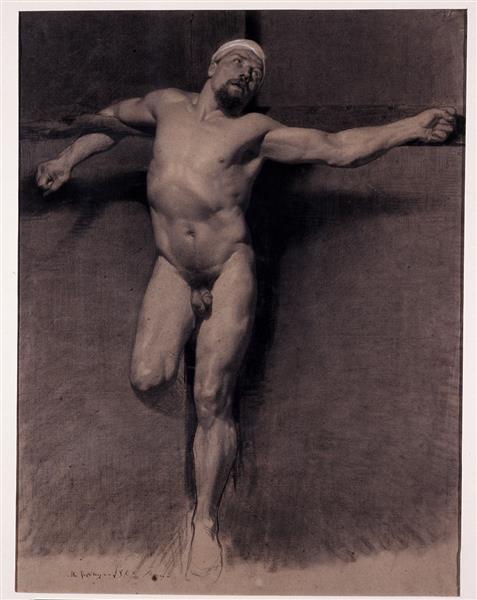Description
The work "Nude Man. Study for a crucifixion" by Mariano Fortuny, dated in 1860, stands out as a splendid example of technical mastery and emotional deepening that characterize the work of the Spanish painter. In this study, Fortuny enters the representation of the human body, an issue that has fascinated artists throughout history. The male figure, represented in disposable way, is configured in a visual dialogue that reveals both the ability to capture the form and the exploration of physiology and light.
The composition is remarkable for its simplicity and its immediate impact. Fortuny provides the model in a position that evokes both vulnerability and intrinsic strength of the human body. The use of light is crucial in this work; The chiaroscuros are used with mastery to model the torso and limbs, creating a perception of volume and three -dimensionality that is both subtle and powerful. Lighting highlights muscle tensions and delicacy of skin treatment, elements that contrast significantly with the vast history of religious art in which the surrender of the body to divinity is a common issue.
The color in this painting is equally important. Fortuny uses a moderate palette, dominated by warm tones that suggest a certain intimacy. The use of clear shadows prevents the work from becoming a purely technical study; Instead, he invites contemplation and reflection on the human condition. The choice of a neutral background ensures that the spectator directs his attention immediately towards the central figure, without distractions.
Although this is a study, it is still a precursor to a more complex work that Fortuny could have conceived in the context of the crucifixion. The naked body, in its total nakedness, becomes a symbol of sacrifice and redemption. Without specifying additional characters in the painting, Fortuny suggests a narrative that transcends the mere physical study; The work evokes the spiritual strength that man finds in his own humanity, a theme that can be reflected in the work of other contemporary artists who also explored the dichotomy between the physical and the spiritual.
Mariano Fortuny, known for his exquisite details and innovative technique, moves at an intersection between romanticism and realism. His ability to merge these styles is clearly observed in this work, where the precision of the human body is intertwined with an emotion that invites the viewer to a deeper understanding of artistic representation. This type of studies was common among the artists of their time, who often elaborated preliminary representations before creating more complex works, providing an interesting look at their creative process.
"Naked man. Study for a crucifixion" is not only a testimony of Fortuny's technical mastery, but also an intimate reflection on the fragility and strength of the human condition. In this work, the nakedness of the body is not simply a physical state, but a vehicle through which emotions and spirituality are explored. Fortuny invites us, through his art, to contemplate these universal issues that resonate even today.
KUADROS ©, a famous paint on your wall.
Hand-made oil painting reproductions, with the quality of professional artists and the distinctive seal of KUADROS ©.
Art reproduction service with satisfaction guarantee. If you are not completely satisfied with the replica of your painting, we refund your money 100%.

